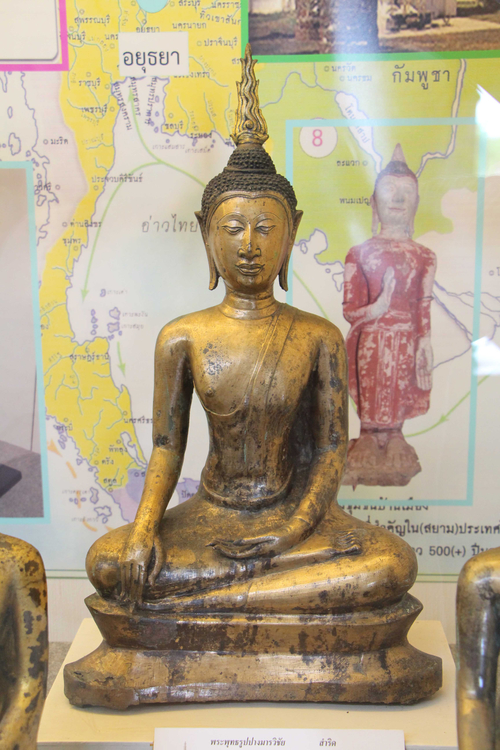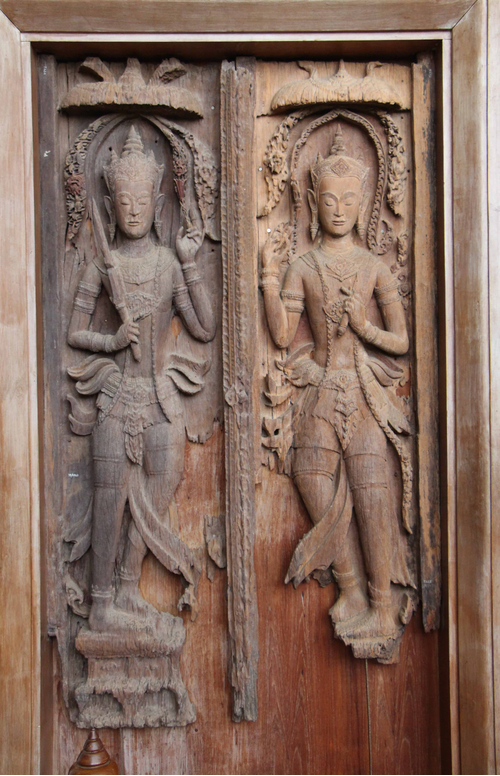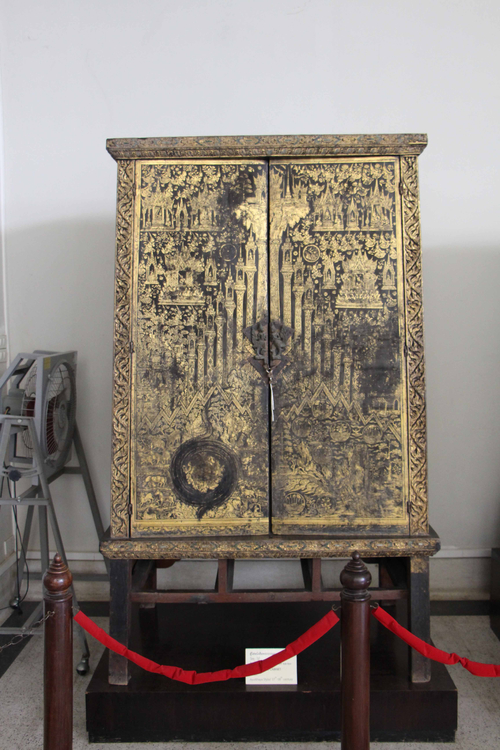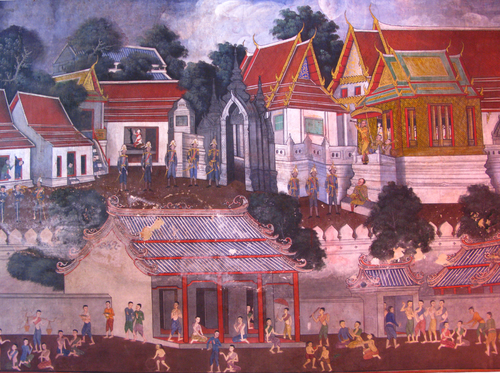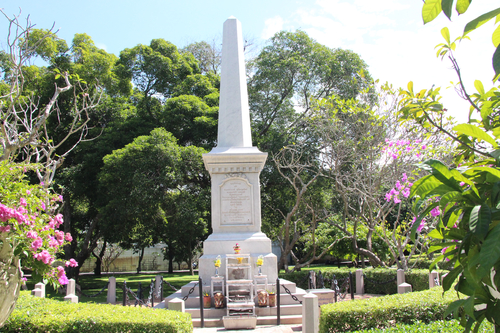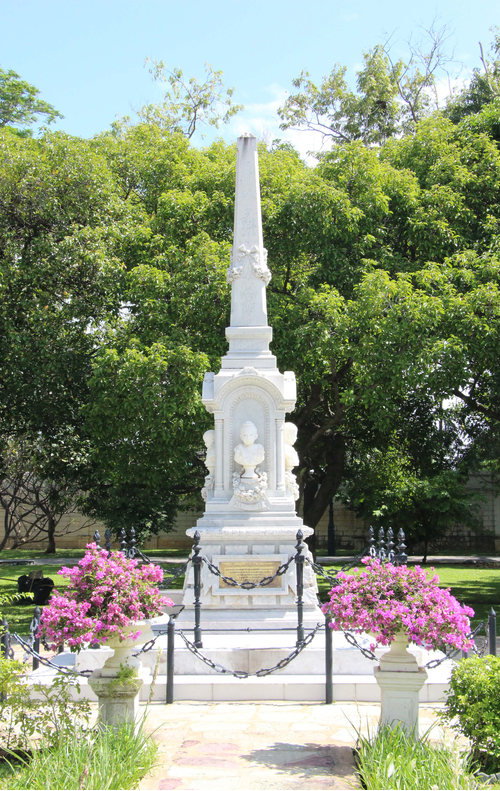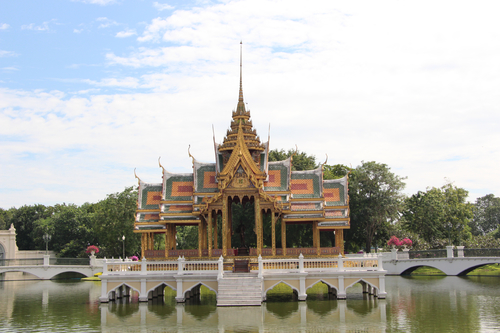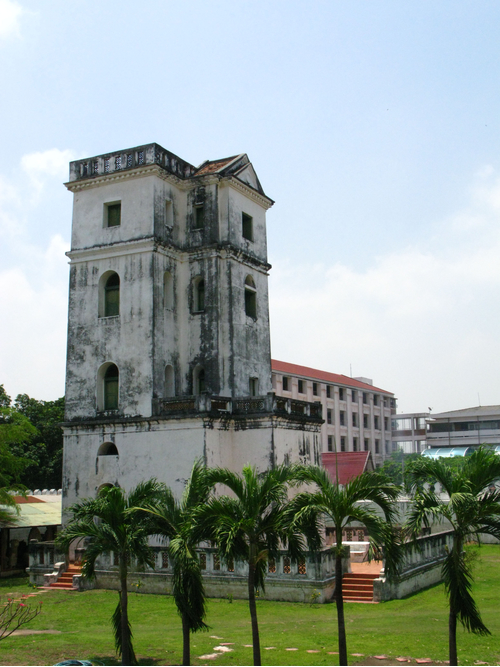ค้นหางานศิลปกรรม
ฐานข้อมูลศิลปกรรมในเอเชียตะวันออกเฉียงใต้
ประติมากรรมพระพุทธรูปปางมารวิชัย
พระพุทธรูปอยู่ในอิริยาบถนั่งขัดสมาธิราบปางมารวิชัยบนฐานบัวที่ไม่มีการประดับตกแต่งใดๆ รูปแบบในภาพรวมสะท้อนถึงการสืบต่อจากพระพุทธรูปรุ่นก่อนกรุงศรีอยุธยา-อยุธยาตอนต้น หรือพระพุทธรูปอู่ทองรุ่นที่ 1 และรุ่นที่ 2 ในขณะเดียวกันก็มีความสัมพันธ์กับพระพุทธรูปหมวดใหญ่ในศิลปะสุโขทัยด้วยรูปแบบสำคัญของพระพุทธรูปองค์นี้ที่สืบต่อจากพระพุทธรูปอู่ทองรุ่นที่ 1 และ 2 ได้แก่ นั่งขัดสมาธิราบพระหัตถ์ทำปางมารวิชัยอยู่บนฐานบัวเกลี้ยงๆ เม็ดพระศกเทียบได้ดังหนามขนุน ส่วนความสัมพันธ์กับพระพุทธรูปสุโขทัยเห็นได้จากพระรัศมีรูปเปลวไฟ พระพักตร์วงรูปไข่ พระขนงโก่งโค้ง แม้มีไรพระศกเช่นพระพุทธรูปอู่ทอง แต่การหยักแหลมที่กึ่งกลางพระนลาฏล้อตามความโก่งโค้งของพระขนงและบริเวณพระกรรเจียก (ขมับ) ไม่หยักแหลม ย่อมสัมพันธ์กับแนวพระเกศาในพระพุทธรูปศิลปะสุโขทัยหมวดใหญ่ พระพุทธรูปองค์นี้ครองจีวรห่มเฉียง ชายสังฆาฏิหรือชายจีวรเป็นแถบสี่เหลี่ยมพาดผ่านพระอังสาซ้ายยาวจรดพระนาภี ปลายตัดตรง พระหัตถ์ขวาวางอยู่บริเวณพระชงฆ์มีความอ่อนช้อยกว่าพระพุธรูปอู่ทองรุ่นที่ 1 และ 2 ซึ่งน่าจะเป็นอีกประเด็นหนึ่งที่สัมพันธ์กับพระพุทธรูปสุโขทัย
ประติมากรรมบานประตูไม้
บานประตูไม้คู่นี้สลักภาพทวารบาลบานละ 1 องค์ รูปแบบเป็นแบบเดียวกันต่างกันเพียงอิริยาบถที่สลับข้างกัน ทั้งคู่ยืนในอิริยาบถพักขาบนฐานสิงห์ พระหัตถ์ข้างหนึ่งยกขึ้นกำช่อดอกไม้ พระหัตถ์อีกข้างหนึ่งถือพระขรรค์พระพักตร์ยาวรี สวมเครื่องทรงหลายอย่าง เช่น มงกุฎที่ประกอบด้วยกระบังหน้าและรัดเกล้ากรวย มียอดแหลมขนาดเล็กล้อมรัดเกล้า กุณฑลทรงตุ้มแหลม กรองศอ สังวาล ทับทรวง พาหุรัด ทองพระกร เข็มขัดรัดพระองค์ ทองพระบาท สวมผ้านุ่งสั้นแต่มีชายผ้ายาว พระเศียรมีซุ้มล้อมรอบทำนองเดียวกันกับประภามณฑล ถัดออกไปเป็นช่อดอกไม้ ถัดขึ้นไปเป็นฉัตร
จิตรกรรมตู้พระธรรม
ตู้พระธรรมใบนี้ทำขาตู้ด้วยไม้สี่เหลี่ยมธรรมดา ไม่สลักลวดลายใดๆ นิยมเรียกขาตู้แบบนี้ว่าขาหมู จึงนำไปใช้เรียกตู้แบบนี้ว่า ตู้พระธรรมขาหมูฝาตู้มีลายลดน้ำ หรือลายลงรักปิดทอง เขียนภาพภูมิจักรวาลในคติพุทธศาสนา ภาพนี้แบ่งเป็น 2 ส่วน โดยมีเส้นสินเทาคั่นแบ่งระหว่างกัน เบื้องล่างของเส้นสินเทาแสดงภาพป่าหิมพานต์อันเป็นป่าที่ชมพูทวีป บานทางซ้ายมือปรากฏภาพสระอโนดาต เป็นสระน้ำรูปวงกลมขนาดใหญ่ซึ่งเป็นต้นกำเนิดของแม่น้ำ 4 สาย แม่น้ำแต่ละสายไหลออกมาจากปรากของสัตว์แต่ละชนิด ได้แก่ ช้าง ม้า วัว สิงห์ ส่วนบานทางขวามือเป็นภาพสระน้ำอื่นๆ ในป่าหิมพานต์ แสดงเป็นรูปสระน้ำวงกลมขนาดเล็กที่มีดอกไม้หรือดอกบัวอยู่ภายใน องค์ประกอบส่วนอื่นมีต้นไม้ โขดหิน และสัตว์ต่างๆ ด้านบนของเส้นสินเทาแสดงภาพเขาพระสุเมรุอยู่ตรงกลาง บนยอดเป็นสวรรค์ชั้นดาวดึงส์ที่อยู่ของพระอินทร์ มีปราสาทซึ่งคงหมายถึงปราสาทไพชยนต์อยู่ตรงกลาง ช้างอเราวัณอยู่ด้านล่างราวกับว่าแบกปราสาทนี้ไว้ จุฬามณีเจดีย์อยู่ทางขวามือ ถัดลงมาทั้ง 2 ข้างจากเขาพระสุเมรุเป็นเขาสัตตบริภัณฑ์ หรือเขาวงแหวนเจ็ดชั้นที่ล้อมรอบเขาพระสุเมรุ แต่ละลูกมีความสูงลดหลั่นกันลงไป แสดงอออกในรูปทรงแท่งเสาจำนวนด้านละ 7 แท่ง แสดงให้เห็นว่าช่างได้วาดภาพเขาสัตตบริภัณฑ์ด้วยมุมมองผ่าแบ่งครึ่ง เหนือเขาแต่ละลูกมีวิมานของเทวดา แวดล้อมเขาพระสุเมรุและเขาวงแหวน 7 ชั้น ยังปรากฏภาพวิมานเทวดาและเหล่าเทวดาในท่าเหาะจำนวนมาก มีวงกลม 2 วงที่แทนพระอาทิตย์และพระจันทร์ด้วย
จิตรกรรมจิตรกรรมเรื่องพระราชพิธีสิบสองเดือน
ภาพเขียนสีฝุ่น ใช้เทคนิคการเขียนภาพแบบตะวันตกโดยคำนึงถึงหลักทัศนียวิทยา ทำให้ภาพมีมิติและระยะใกล้-ไกล ใช้ภาพพระมหาปราสาทและอาคารต่างๆในพระบรมมหาราชวังเป็นฉากหลังในการเล่าเรื่อง ภาพอาคารบ้านเรือน ภาพการแต่งกายของบุคคลไม่ว่าจะเป็นขุนนาง ทหาร และชาวบ้าน เป็นไปตามสมัยนิยมในขณะนั้น
สถาปัตยกรรมอนุสาวรีย์สมเด็จพระนางเจ้าสุนันทากุมารีรัตน์ พระบรมราชเทวี
เป็นอนุสาวรีย์หินอ่อนแกะสลักจากประเทศอิตาลี ลักษณะเป็นฐานรูปทรงสี่เหลี่ยมและยอดหกเหลี่ยมทรงสูง มีรายละเอียดดังนี้ผนังด้านทิศตะวันตก ปรากฏข้อความดังนี้ที่รฦกถึงความรักแห่งสมเดจพระนางเจ้าสุนันทากุมารีรตน์พระบรมราชเทวี อรรคมเหษีอันเสดจทิวงคตแล้วซึ่งเธอเคยมาอยู่ในสวนนี้ โดยความศุขสบายแลเปนที่เบิกบานใจพร้อมด้วยผู้ซึ่งเปนที่รัก แลที่สนิทอย่างยิ่งของเธออนุสาวรี นี้สร้างขึ้นโดยจุฬาลงกรณ์ บรมราชผู้เปนสวามี อันได้รับความเศร้าโศกเพราะความทุกข์อันแรงกล้าในเวลานั้น แทบจะถึงแก่ชีวิตรถึงกระนั้นยังมิได้หักหายจุลศักราช ๑๒๔๓ผนังด้านทิศตะวันตก ปรากฏข้อความเป็นภาษาอังกฤษในความหมายเดียวกันกับด้านทิศตะวันออกผนังด้านทิศใต้ สลักเป็นตัวอักษร "ส" ภายใต้พระมงกุฎ หมายถึงอักษรพระนามาภิไธยในสมเด็จพระนางเจ้าสุนันทากุมารีรัตน์ พระบรมราชเทวีผนังด้านทิศเหนือ สลักเป็นรูปเครื่องราชอิสริยาภรณ์อันเป็นโบราณมงคลนพรัตนราชวราภรณ์
สถาปัตยกรรมอนุสาวรีย์ราชานุสรณ์
เป็นอนุสาวรีย์หินอ่อนแกะสลักจากประเทศอิตาลี ลักษณะเป็นแท่นรูปทรงสี่เหลี่ยม แต่ละด้านแกะลวดลายเป็นคูหาสำหรับประดิษฐานพระรูปหินอ่อนแกะสลักเจ้านายที่สิ้นพระชนม์ไปแล้วทั้ง 4 พระองค์ เหนือขึ้นไปเป็นแท่งเสาทรงสี่เหลี่ยมสอบขึ้นไปจนถึงยอด
สถาปัตยกรรมชื่อหลัก พระที่นั่งไอศวรรย์ทิพยอาสน์
พระที่นั่งไอศวรรย์ทิพยอาสน์เป็นพระที่นั่งทรงปราสาทจตุรมุขโถงจำลองแบบมาจากพระที่นั่งอาภรณ์พิโมกข์ปราสาทในพระบรมมหาราชวัง มุขด้านทิศตะวันออกและตะวันตกเป็นมุขสั้นหลังคาลดสองชั้น ด้านหน้าและด้านใต้หลังคาลดสี่ชั้น เครื่องยอดทรงปราสาทประดับด้วยครุฑยุดนาคที่มุมทั้ง 4 หน้าบันทั้ง 4 ด้านประดับตราอาร์มหรือตราแผ่นดินในสมัยรัชกาลที่ 5 มีเสารับย่อมุมไม้สิบสอง มีชานประกอบกำแพงแก้วทั้ง 4 ด้าน ด้านตะวันตกมีอัฒจันทร์ลงสู่สระ คานล่างก่อเสาคอนกรีตรับพื้นองค์พระที่นั่งทรงสามเหลี่ยม
สถาปัตยกรรมหอพิสัยศัลยลักษณ์
มีรูปแบบเป็นอาคารหอคอยสูง 4 ชั้น ตั้งอยู่บนฐานอาคารที่มีลานกว้างซึ่งมีบันไดและพนักระเบียง ภายในอาคารมีบันไดเวียนขึ้นไปสู่ชั้นบน ชั้น 2 มีระเบียงออกมาสู่ภายนอก ประดับพนักระเบียงด้วยกระเบื้องเคลือบ มีการใช้ระบบผนังวงโค้งช่วยรองรับน้ำหนัก ผังอาคารมีลักษณะคล้ายหอสูงทรงสี่เหลี่ยมประกบกัน 2 ชุด ดังนั้นจึงมีหลังคา 2 ส่วน คือส่วนที่เป็นสามเหลี่ยมหน้าจั่ว และหลังคาตัดทรงสี่เหลี่ยม ตัวอาคารก่ออิฐฉาบปูน ช่องหน้าต่างมีลักษณะเป็นช่องวงโค้งมีบานไม้เปิด -ปิด ยกเว้นช่องหน้าต่างชั้นบนสุดที่เจาะเป็นช่องสี่เหลี่ยม
